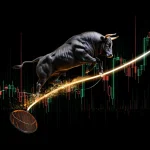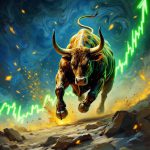Mass Madness: The Turning Point for the Astute to Win
Jan 27, 2025
The unstoppable tide of mass madness has toppled empires, shattered dynasties, and devoured countless souls—all because the many, like lemmings, rushed heedlessly toward the precipice they feared most.
Throughout history, we have seen entire civilizations crumble beneath the weight of collective delusions. From the medieval witch-hunts to modern-day stock market panics, large groups march in sync toward ruin, moved less by concrete facts than by raw emotion. In these tumultuous times, individuals with cunning, self-command, and profound insight rise above the herd, securing positions of influence and shaping the destiny of others. Indeed, as Machiavelli observed, fortune can be seized by those wise—or ruthless—enough to read the crowd’s psyche. At the same time, Montaigne’s reflections remind us that man’s greatest folly often comes from overconfidence and blind imitation. A perennial drama emerges: a grand spectacle where the multitude succumbs and a select few ascend, weaving bright new threads in the tapestry of power.
Too often, the term “mass madness” conjures visions of delirious mobs and frenzied chants, but it is far more subtle—and far more pervasive—than that. It seeps into digital wires and social feeds, manifesting as fervent hashtags, viral rumours, and ideological crusades that can mobilize millions in the blink of an eye. The cunning break through this din, dissecting the illusions that entangle their contemporaries. In that razor’s edge moment—when mania seizes the majority—those who stay grounded reconfigure the landscape, exploiting the chaos to emerge stronger, more secure, and often, more revered.
Seeds of Collective Delusion
While mass madness may appear as a sudden, cataclysmic wave of irrational energy, it often germinates from smaller kernels of unease, nurtured in the shadows until they flourish uncontrollably. People, in their most basic nature, crave certainty and belonging. The vulnerability to join a frenzied crowd that offers a sense of “knowing” and “unity” is etched deep in our social DNA. A rumour, a conspiracy, or an overblown threat can ignite panic, prompting everyone to gather in protective clusters. Whether fleeing from an imaginary terror or flocking to a self-proclaimed prophet, the impetus is often the same: fear, hope, or the promise of salvation.
Machiavelli counselled princes to harness these base instincts. Upon discerning the masses’ anxieties, a ruler could channel them, bending popular will to suit his objectives. The brilliance lay in creating the image of stability or the bogeyman of external threat, fanning latent paranoia, and emerging as society’s indispensable saviour. Standing outside the brutal intrigues of the court, Montaigne would gnaw at the moral tensions in such manipulations, cautioning against moral corruption. Yet both thinkers would agree: if one fails to understand the psychological tinder of a crowd, one remains powerless when hysteria ignites.
Today, these seeds can be sown more swiftly. An outrageous headline or a viral post can breach the gates of reason, planting false narratives in open minds. Once this collective delusion takes hold, each new share or comment compounds the mania. In short, the madness takes on a life of its own, spreading beyond anyone’s immediate control—except, perhaps, those with eyes keen enough to see how the wind blows.
The Herd’s Plunge: Historical Lessons
History abounds with cautionary tales of how swiftly throngs can lurch from careful reason to unbridled frenzy. Consider the French Revolution, wherein a complex tapestry of social injustices and economic pressures built the scaffolding for revolt. When hysteria eventually took the form of unyielding suspicion and the Reign of Terror swept across France, countless innocents met the guillotine under the slightest hint of treason. From a Machiavellian vantage point, the potent lesson is that once fear has been sufficiently stoked, the crowd’s hunger for scapegoats becomes insatiable, devouring even the revolutionaries themselves.
Centuries earlier, the mania of the witch trials in Salem demonstrated the terrifying potency of group delirium. Entire communities turned against their neighbours, inspired by breathless accusations concerning supernatural malice. Hearsay became incontestable evidence, and no one was safe. Montaigne might have observed the cultural and intellectual vacuum and entrenched superstitions that allowed rumour to morph into absolute “truth.” Meanwhile, albeit fleetingly, the individuals who whispered the most persuasive stories about devils and enchantments quickly grasped the reins of local influence.
But mass madness is not confined to the annals of pre-industrial societies. The 20th century’s totalitarian regimes thrived on orchestrating propaganda so compelling that large segments of the populace embraced genocidal fervour with disconcerting ease—elaborate mythologies of threat or betrayal often justified revolutions, purges, and wars. For instance, entire populations were led to blame an ethnic or political minority for their economic woes, spoiling centuries of peaceful coexistence. The pattern persists: inflame fear, manufacture a unifying lie, and lead the crowds to see themselves as participants in a sacred or heroic mission, no matter how horrifying the consequences.
We also see milder but still striking instances in modern financial bubbles. Tulip mania in 17th-century Holland or the dot-com bubble at the turn of the 21st century taught us that rational men and women—convinced that an asset will forever appreciate—will pour their life savings into illusions. As Montaigne noted, the quest for wealth often tangles with our inability to accept that fortunes can vanish. Once again, a few savvy minds recognized the illusions at play, sold their holdings in time, and left the rest to face the aftermath.
Emotional Contagion: Fuel for the Fire
At the core of mass madness lies emotional contagion: the near-viral way in which one person’s fear or fervour transmits to the next. This phenomenon relies on an essential feature of human interaction—the desire to empathize or belong. In times of crisis, we subconsciously scan the faces and body language of those closest to us. If a handful of individuals display profound alarm or fervent conviction, it often triggers a domino effect, igniting a tidal wave of solidarity or terror.
The cunning exploits this dynamic by controlling how emotion is projected. A skilled speaker, for instance, might feign outrage or piety to galvanize a crowd, well aware that the slightest display of hesitation or contrasting sentiment can unravel the spell. The more carefully choreographed the gesture, the more thoroughly the throng succumbs to the orchestrator’s will. Machiavelli advised rulers to cultivate a public aura that aligns with the mass’s anxieties or desires—seem devout in front of the pious, appear vigilant in a time of war, or project paternal compassion when the populace is desperate for reassurance. Emotional contagion makes these signals self-reinforcing: doubters get drowned out by the majority’s rising clamour.
Montaigne, renowned for his introspective nature, might have meditated on the moral weight of succumbing to the crowd’s mania—how easily rational discourse buckles under the momentum of raw feeling. Once the emotional current picks up speed, it seeps into every corner of social life: in whispered rumours behind closed doors, in sensational media headlines, or in social media comment threads that multiply every hour. Few question the foundations as soon as large numbers echo the same chorus.
Biologically, modern psychology suggests that mirror neurons—responsible for empathizing with others—accelerate the spread of mass emotions. When social media amplifies these cues globally, an upheaval in one corner of the world can rattle markets, elections, or social structures thousands of miles away. The result is a swirling vortex of panic or euphoria transcending physical boundaries. Unless they ground themselves in reflective thought, individuals can find it nearly impossible to remain calm or neutral. The cunning, however, cultivates internal checks. They recognize they need not adopt the crowd’s perspective, no matter how overwhelming it may feel. Instead, they channel mass emotion into a stepping stone: rallying followers for a cause, redirecting anger into activism, or seizing the advantage during a moment of universal distraction.
Yet the line between harnessing emotional contagion for positive transformation and exploiting it for dark ends is perilously thin. The threads of manipulation can bind the manipulator as well, especially if they begin to believe their own theatrics. This was the downfall of leaders who, after orchestrating hysteria, forgot to moderate it. Eventually, the flames consume them too, a grim demonstration of how the line between the cunning puppet master and victim is easily blurred in the throes of mania. The difference lies in a discipline that steadfastly questions each wave of excitement or terror—even if that means standing apart, risking ostracism by the emotional horde.
Calculated Contrarianism: The Art of Standing Apart
One hallmark of the ascendant minority lies in their capacity for intentional contrarianism. Instead of following the herd over the cliff’s edge, these individuals quietly analyze both fact and fiction, searching for the inherent flaw in each upsurge of collective thinking. This contrarian stance can look cold, even antisocial, to those enmeshed in the mania. Yet, as Machiavelli would argue, if a course leads inevitably to self-destruction, it is not cruelty but wisdom to choose a divergent path.
Contrarian thinking isn’t merely about refusing to join the crowd; it’s about strategic timing. Resist too soon, and the majority brands you a heretic or fool. Resist too late; you wind up tethered to the same doomed fate. The cunning observer discerns when mania begins to peak, quietly extricates themselves from its illusions, and, in certain contexts, even shoulders the role of a public antagonist to incite reevaluation. Montaigne, on the other hand, might underscore the nuanced moral dimension: humans must weigh how their solitary stand impacts not just personal advantage but communal well-being.
In financial realms, contrarianism can manifest as “buying when others are selling,” exemplified by legendary investors who accumulate wealth in recessions while the masses panic. In social upheavals, the contrarians question official propaganda, rummaging for hidden motives in government decrees. In ideological waves, they become the outliers who champion a deeply unpopular viewpoint, only to be vindicated by history years later.
Still, the path of the contrarian is not for the faint of heart. It entails risk, isolation, and the constant threat of backlash from the impassioned majority. The contrarian must also be adept at camouflage: there are points where open defiance is suicidal and times when prudence advises a subtler form of resistance. Machiavelli suggested that a prudent prince sometimes feigns alignment with the mania of the masses, even while privately cultivating a starkly different agenda. Often, the cunning will appear to yield, share in the illusions for a while, and then pivot at just the right moment, reaping the rewards of a sudden and dramatic reveal.
Harnessing Chaos for Transformation
Even the bleakest manifestations of mass madness can spawn unexpected innovations. When the established structures teeter on the brink, individuals with foresight and resilience can introduce new frameworks that last well beyond the meltdown. Indeed, the crisis is often a cradle for rebirth: empires fade, tyrannies collapse, but from the rubble, survivors sometimes carve out fresh paradigms in governance, economics, or culture. Machiavelli would likely note that power abhors a vacuum. Thus, those who maintain clarity amid chaos are perfectly positioned to lead once the dust settles.
Consider the aftermath of the Black Death in the 14th century. As death rates skyrocketed, feudal bonds frayed, and labour became scarce. The tragedy pushed Europe to rethink longstanding hierarchical norms, facilitating wage increases and eventually catalyzing social mobility. The tragedy was unstoppable, but certain entrepreneurial and forward-thinking figures, particularly in urban centres, leveraged the disruption to negotiate new trade opportunities, revise archaic feudal arrangements, and champion unprecedented forms of governance.
Social and economic panics have sometimes spurred major technological leaps in contemporary settings. Recessions, for instance, can push investors and engineers to redirect capital and innovation into more viable, future-focused industries. We can see how the “winners” anticipate this pivot before the crowd. When the herd acknowledges a new technology’s potential, the cunning has already established a foothold—patents filed, companies formed, and networks built.
Yet harnessing chaos for something constructive is not solely an act of shrewd opportunism. Montaigne would probe the moral or philosophical ramifications: transformations built on ashes might replicate the same despotisms or illusions that preceded them. Indeed, revolutions that began with noble ideals descend into carnage, only to enthrone a new tyrant with the same old vices. The question, then, is whether the wise among us—those who remain lucid during mass fervour—can secure personal advantage and cultivate a culture capable of resisting the next wave of mass madness.
Tactics for Surviving—and Thriving—in the Hive Mind
Given the inevitability of cyclical panics and hysteria, individuals must cultivate strategies to shield themselves from the destructive pull of the mass mind. Some of these tactics are practical, others psychological:
- Know Thyself: A Machiavellian principle reinterpreted, self-knowledge allows you to remain unmoved by the festering illusions around you. Montaigne’s essays stress the importance of self-scrutiny. Understand your convictions deeply so that collective mania cannot rewrite them unchallenged.
- Observe Before Acting: The cunning do not rush to the front lines of any movement or mania. Instead, they stand on the periphery, watchful. By identifying who stands to gain, who is fueling the narrative, and which direction the emotional tide flows, you can decide whether or when to engage.
- Maintain Plurality of Information: Just as financial investors diversify portfolios, wise individuals diversify their sources of knowledge. Do not rely exclusively on the loudest voices or a single social group. Explore contrarian thinkers, peruse foreign news outlets, read balanced historical analyses—anything that breaks the self-reinforcing feedback loops of mass hysteria.
- Master the Power of Silence: Words can inflame or placate. Strategic silence can be a shield, giving you time to evaluate swirling rumours without committing too early. Cautious restraint keeps you off the radar of those commanding the mob, yet you remain vigilant and ready to act immediately.
- Engage Allies Sparingly: Standing alone might be heroic, but it is also perilous. Realists recognize the need for alliances. Yet, be selective. Allies who are too hot-blooded can drag you into the mania. Surround yourself with those who also prize levelheadedness or who can at least keep hush when storm clouds gather.
- Plan an Exit Strategy: Whether it is physical relocation, changing allegiances, or shifting investment portfolios, always have an escape route. Once mania transforms into unstoppable destruction, the only recourse might be to flee. Machiavelli’s counsel remains relevant: sometimes survival demands retreat, so you can re-emerge once the chaos recedes.
With these tactics, the astute preserve their sovereignty of mind. No matter how loud the drumbeats, how fierce the propaganda, or how dire the warnings are, they remain aligned with their own reason—and ready to pivot advantageously when the environment shifts.
The Final Reckoning: When Winners Ascend
Whether in ancient Rome, revolutionary France, or the digital global village of the 21st century, mass madness remains an ever-present spectre. When it takes hold, the many are swept away by illusions, illusions they—tragically—create, feed, and defend. Montaigne might have sighed at the tragedy of human frailty, forever repeating the same mistakes because humans fail to examine their illusions with enough rigour. Machiavelli, on the other hand, might relish in how fertile the bedlam is for any leader who can plant seeds of ambition, thereby harnessing the storm to their advantage.
In the end, winners rise precisely because they manipulate—or at least anticipate—the mania that unmakes everybody else. But the moral dimension remains: Is it enough to merely outwit the crowd, or must one be responsible for mitigating harm? For some, the thrill of power is ample reward. Shaping a more enlightened society after the chaos might be a real victory for others. Indeed, the greatest transformations occur when cunning merges with conscience, forging leaders who not only outrun the rampaging herd but also help others see a safer path.
When the mania subsides, a new hierarchy takes shape: those who soared above the panic now occupy positions of influence, dictating the new norms. The destructive impetus that once fueled calamity can evolve into constructive energy under the right stewardship. The question is whether the next wave of mania will find that new order more resistant or, as so often is the case, only reconfigured for a new brand of fervour.
Regardless, mass madness is as old as humanity itself—a reflection of our vulnerability to illusions, our hunger for belonging, and our fear of uncertainty. As lemmings plunge en masse off a cliff, the crowd rarely sees the danger until it is too late. Yet, scattered among that mass are the watchers, the contrarians, and the opportunists—those who remain as calm as a harbour in the fiercest gale. In them lies the seed of renewal, for better or for worse.
When illusions dissolve, and the dust of hysteria settles, one truth flickers: another wave of mania is always lurking beyond the horizon. The impeccable synergy of Machiavellian cunning and Montaignean reflection can illuminate a path through that darkness. We preserve ourselves by acknowledging the cycle, refining emotional discipline, and—if needed—stepping outside the swarming throng. And, perhaps, in that act of self-preservation, we sharpen the future’s moral and intellectual edge, ensuring that not all must tumble like lemmings into the yawning void.
Shattering Limits: The Art of Mental Exploration













